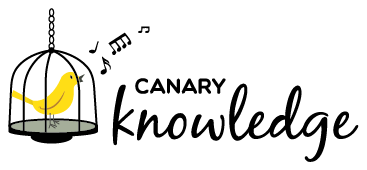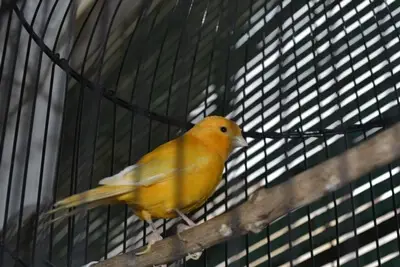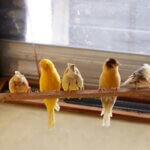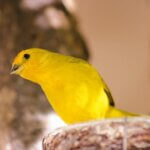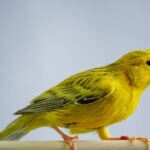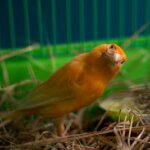A canary can lose the ability to fly, but this doesn’t happen naturally. Much like a human losing its ability to walk, a canary must sustain a disability to lose this crucial part of its biology.
According to Evolution, birds can fly due to integrated muscles spread across their wings, feet, tails, and main abdomens. So, damaging these structures can negatively impact a canary’s flying ability.
If the damage is severe, the canary may be permanently unable to fly. Without medical intervention and care from the owner, a canary won’t survive for long. The risk of the injury or illness progressing to a life-threatening point, even beyond costing a canary of its flight abilities.
In most cases, when an owner realizes that a pet bird is struggling to take to the air, it’s because of a temporary malady. The loss of flight will fade as the canary recovers.
It’ll require a time of isolation, emotional distress, and physical healing, but the canary will regain its flight ability and return to its normal behavior.
Why Do Canaries Stop Flying?
A flightless canary may sit at the bottom of its cage and can’t reach the higher parts.. It might flutter around or show a lack of coordination.
As time goes on, it may look ill when it can’t preen itself or reach food and water.
Here are the reasons why canaries stop flying and what you can do to help:
Psychological Wounds
If you recently bought a canary and discovered it’s reluctant to fly, it may be due to having its wings clipped too early, too often, and with bad technique.
Even if the wings later grew back healthily, they may still be psychologically de-clipped, so to speak, and may choose not to fly. Due to their small size and prey status, canaries are psychologically sensitive.
Taking away their wings before they learn to properly use them, limiting their ability to fly altogether, or harming the wings will cause them to adapt to their situation.
Such a canary may not realize it can fly or believe it’s too dangerous, as it may experience pain or fly into objects from a lack of coordination.
Care should help your canary recover with time. Allowing its wings to grow out and encouraging safe flight in a protected environment should help them learn to reclaim this part of its biology.
Canaries with psychological wounds can still fly properly when needed and usually don’t have a problem perching or eating. They choose not to fly most of the time or when you’re around.
Badly Clipped Wings
Poorly clipping your canary’s wings can lead to physical pain and even permanent damage to the wings, making flight extremely painful or impossible.
A common mistake is to clip the blood feathers, which, as the name implies, will bleed heavily and engage pain receptors all through the canary’s wing.
If this wound isn’t properly treated, or the blood feathers are routinely clipped, this can be excruciating and even fatal. Blood loss, infections, and shock are all risks. At the least, your canary may avoid using its wings at all costs, thus losing its ability to fly.
To prevent this, have your canary’s wings trimmed by a vet. Alternatively, pay close attention to every feather before you cut it. Blood feathers are darker than the others as blood flows through them.
Sickness
Canaries are susceptible to bacterial and viral infections, like mycoplasma, air sac mites, and canary pox.
According to the Journal of the American Veterinary Medical Association, these have high mortality rates. Although most known illnesses are respiratory, advanced infections will cause general body weakness and lethargy. This, subsequently, affects flight ability.
A tired and sickly canary will not be interested in flying, and it’s likely to hunker down to conserve energy and warmth and draw little attention to itself. The canary may resume flying once it has recovered naturally or received medical attention.
However, one disease impacts the wings directly: feather cysts. Domestic canaries are more likely to develop feather cysts than other birds since most have undergone selective breeding.
This impacts their genetics and raises the chances of mutations. Some are harmless and only impact the size or color of a bird, while others have unintended side effects.
So, feather cysts typically occur when feathers can’t push through the follicle and remain under the skin. If your canary is refusing to take flight, check over its wings to try and identify bumps, redness, swelling, or general irritation.
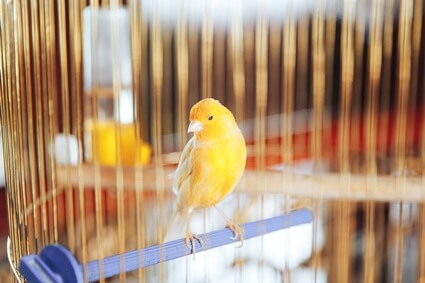
Injury
Injury to the legs or wings can temporarily affect a canary’s ability to fly.
Leg injuries are especially common since canaries have thin, brittle legs. They may wound themselves on cage bars, in fights with other birds, or from stress-induced self-harming.
Injured feet don’t necessarily prevent canaries from flying. However, they make it hard for the injured birds to perch or move freely, forcing them to stay laid in the cage. When perching is painful, a canary will avoid flying, so it doesn’t need to use its feet to land.
Wing injuries have a direct impact on flight. They usually occur due to fights with other birds or altercations with other pets, like cats.
Such an injury could manifest as a refusal to fly or, more likely, several bad attempts at flying. The canary may flutter around its cage or take to the air, only to lose balance and crash into something.
A severe injury will need the help of a vet, as the canary will be unable to navigate, it may be in extreme pain, or infections could occur.
Milder injuries will have the canary babying its wing until it heals. As long as it can eat, drink, sleep, and groom, your vet may recommend waiting and watching to ensure it doesn’t get worse.
Complications In Old Age
Canaries can live for up to 16 years, and as they age, they lose muscle mass.
According to the Journal of Animal Ecology, the flight muscle phenotypes will change in birds according to age and sex. Younger male canaries are the most energetic flyers, while older ones are less eager to strain themselves.
Of course, an older canary should not lose its ability to fly. It may choose to fly less often, but it’ll still be capable of it. The danger comes as the canary’s immune system grows weaker, its exercise lessens, and its body becomes frail. This makes it far more vulnerable to the other causes listed above.
Beyond that, an elderly canary may appear to lose its flight ability as it starts to pass on. If your canary is about to expire from old age, it may lie on the bottom of its cage and refuse to fly.
